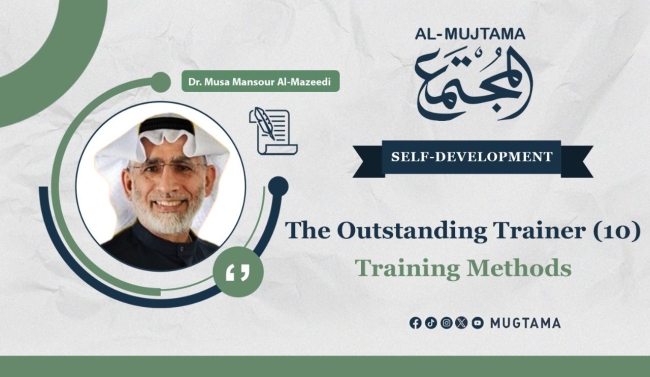Among the key attributes and traits of an outstanding trainer is the ability to avoid filling sessions with unnecessary words, philosophical theories, and unsupported hypotheses—whether from sociology, psychology, management, or other humanities fields.
There are countless training methods, with new ones emerging every day. Some of these innovative techniques have proven captivating and effective. Among them:
Sharing Real-Life Stories Relevant to the Training Topic
When telling a story, the trainer should mention the date, location, and people involved, along with the moral of the story, which makes it particularly engaging for participants. The duration of the story should typically be between 3 to 10 minutes.
Here’s an example of a real-life story: During a training session for the Ministry of Commerce and Industry in Kuwait titled "Communication Skills in Presentation and Public Speaking," I shared the story of a girl named Fatima, who completed the eighth grade at a British school in Salwa, Kuwait, in May 2001.
Fatima wanted to transfer from a British-system school to an American-system one. I asked the participants to write down the ten most important communication elements while listening to the story.
According to the story, Fatima wished to complete high school at an all-girls’ American school in Salwa. Admission required passing an entrance exam.
When the school principal, Ms. Morgan, reviewed Fatima’s results, she was shocked to find that Fatima had failed the exam miserably. The school rejected her application.
Among the Training Methods: Sharing Real-Life Stories Relevant to the Course Topic
Fatima, however, pleaded with Ms. Morgan for a second chance, saying it was important to her. After much back-and-forth, Ms. Morgan agreed and set a new test date on September 5, giving Fatima one final opportunity.
Fatima took this challenge seriously, prepared all summer, and sat for the exam again. But she felt she hadn’t performed well the second time either. Fatima then called Ms. Morgan and requested to meet with her before the results were posted.
Ms. Morgan agreed, giving her just one minute to make her case.
Despite the tight time constraint, Fatima accepted the challenge. She practiced a method from Sam Horn’s book "Concrete Confidence," which teaches how to capture someone’s attention in 7 seconds using the SMILE technique:
- S = Smile at the face
- M = Make the shake of hand
- I = Introduce yourself
- L = Learn the name of the other party
- E = Eye contact the other party
Fatima practiced the technique until she mastered it. The next day, she arrived 15 minutes early. When she met Ms. Morgan at exactly 10 a.m., she smiled, shook her hand, introduced herself, and asked, "Are you Ms. Morgan?"
Ms. Morgan, impressed by Fatima’s confident demeanor, invited her to speak.
Fatima said to herself: Seven seconds of the interview have passed, 53 seconds remain. At this point, Fatima began to deliver her 18-second, well-rehearsed 36-words introduction. She said:
"Madam, I have five reasons why I insist on being accepted into your respected school:
First: This is my desire.
Second: It’s my parents’ wish.
Third: Your school has an excellent reputation.
Fourth: All my friends were accepted, and I want to be with them.
Fifth: I want to complete high school at a girls-only school."
Ms. Morgan was stunned and asked, "Are you a skilled politician? Go home, and I will call you within two hours."
Fatima left, wondering if her 25-second pitch had succeeded.
Two hours later, Ms. Morgan called:
"Although you performed poorly on the exam, our school would be honored to have a student like you. Welcome!"
.. Presenting the Latest Statistics and Allowing Trainees to Comment on Them
After hearing this story, participants listed the following communication elements: persistence, embracing challenges, preparation, practicing the SMILE technique, smiling, shaking hands, introducing oneself, engaging with others, maintaining eye contact, organizing ideas, and managing time.
Thus, an outstanding trainer conveys ideas through real-life stories that resonate with the session’s topic.
Sharing Statistics
An outstanding trainer also uses relevant statistics and invites participants to read and comment on them.
For instance, in a "Customer Service Excellence" workshop for Boubyan Bank, a series of statistics was presented as questions:
1. Did you know that out of 20 dissatisfied customers, only one complains directly to the company, while 19 share their complaints with others?
2. Did you know that each dissatisfied customer tells 10 people outside the organization about their experience?
3. Did you know that solving a dissatisfied customer’s issue increases the chance of them returning to 54%?
4. Did you know that quickly resolving a complaint raises the likelihood of a customer returning to 96%? Speed is key!
5. Did you know that each satisfied customer tells five people about their positive experience?
It is crucial for an outstanding trainer to present statistics related to the session, allow participants to reflect on them, and encourage a discussion on their relevance and applicability to their own work environments.
-------------------------------------------------------------


